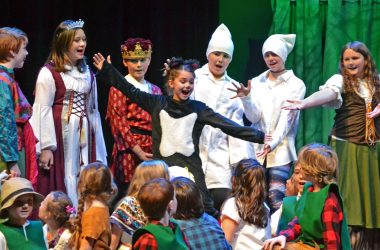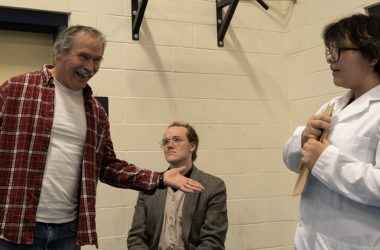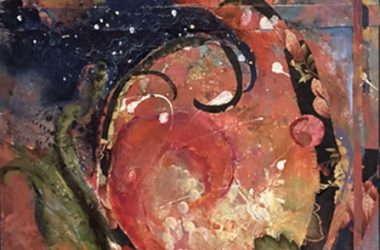by David K. Rodgers
HARDWICK – Since April there has been a show at the Third Floor Gallery of the Hardwick Inn of some 46 photographs by Ross Connelly, former owner and editor of the Hardwick Gazette with his wife, Susan Jarzyna from 1986 to 2017.
As he writes in his Artist’s Statement, “As a Political Science major in college I also took a number of photography and film courses. An apprenticeship with a photographer after college furthered my interest.”
After retiring he has returned to this previous passion, and he says, “Photography is fun and expressive. Preparing this and other displays brings purpose for me and, hopefully, thoughtfulness for those viewing them.”
These works can be roughly divided (with some overlap) into six categories: Vermont and New England Scenes, landscapes in Ireland, animals, more abstract subjects, humor, and political commentary.
Vermont and adjoining states’ photographs are “Nestled Below Venus,” a striking,
carefully balanced composition at twilight; “Stick Season Too,” an early spring view before tree leaves unfold, with a white horse coming towards the observer, well structured; “Abandoned Sugar House,” a winter setting somewhat melancholy; “New Snow,” a forest of thin trees plastered with patches of snow on their trunks, forming an almost abstract visual rhythm; “Old Depot,” taken
at night with a dramatic diagonal perspective; “Floating in Fog,” a small motor boat at the edge of a fog bank with a man in a red coat, focusing our attention effectively; “Wind Power,” the beautiful sight of a schooner under full sail off the coast; “Eaton Brook in Winter,” the waters of a stream appearing black, juxtaposed with the surrounding snow.
Connelly has been to Ireland four times, first in 1968. His family originally came from there and quite poignant are two photos of his ancestral home, an old stone house with broken windows, “now a sheep shed” and “58 years later” from when he first visited it. Most of the landscapes are from the counties of Kerry, Clare, and Galway on Ireland’s southeast and western coasts. “Doolin Pasture” shows typical rolling, treeless grasslands with converging stone walls and a single brown house, creating a harmonious whole; “Turf 1 and 2” picture curious rows of separate piled stones in a field, to what purpose is unclear; three shots evoke the interesting seaside town of Dingle; “Sailing as Performance Art at Bight” captures the excitement of a small boat in a strong wind; “Grazing below Dungore Castle” contrasts a dark, looming tower with the omnipresent sheep of the countryside.
Even though photography is a medium considered as “realistic”, it can take on a level of abstraction by concentrating on bold patternings as in “Sleeping Mermaid,” a curving channel formed by water running off the sand on the beach between tides; “Work Clothes,” the eye-catching orange of weather proof pants hanging up against the white hull of a fishing boat; “Pandora’s Box,” the name of a house or store whose walls, door and multi-paned windows are so coated with sticky snow as to make them look ghostly; “Number Six, Near the Spanish Arch, Galway,” has a double front door painted a strong blue-green that makes it almost transcend its obvious purpose; “Stone Wall” consists of carefully laid stones in a vertical pattern taken very close up, without any surrounding context; similarly in “Off the Ballybunion Strand,” gray seaweed filling the whole photo becomes a textured abstraction; “East of Denver” is taken out of an airplane window, showing the wing tip of the plane against an evening sky, brown below, blue above, in intense light; “Tree Shadows on Snow” has just the shadows on snow of trees out of sight to the left, an ethereal effect; “Intersectionality, A Visual Metaphor,” makes something extraordinary out of the otherwise mundane curves of the tire tracks of cars in light snow upon a road; and, finally “Jack Frost Was Here” reveals the magic of ice crystals growing on a window pane.
The category of animals includes “…and Run with A Big Stick,” an action shot of a brown Labrador Retriever characteristically enjoying a sizeable tree branch; “Reflections,” a particularly beautiful picture of a Great Blue Heron in its distinguished pose at the edge of a pond; “Robert de Niro Loon” must have been taken with a telescopic lens to have such an immediate and startled presence; “Big Dog” has enlarged footprints in the snow tinted blue in an unusual change of scale. Several photographs have a subtle sense of humor: “Global Economy in Connemara” discovers the unlikely combination of an Irish landscape with a fence post in the foreground capped with an upside down Ben & Jerry’s Ice cream container!; “Big Foot” invokes the mythological woodland creature with a single foot track in the snow; “Waiting for Godot?” has an amusing view of a gangway leading to a ship seemingly named Samuel Beckett; “Mondrian on Ice” shows ice on a body of water cracked up into improbably regular rectangles; “Into the Woods” has a groomed trail stretched out in front with only the tips of skies visible in the bottom foreground.
And, lastly, those works of political commentary, starting with “Protest, Washington D.C. 1967, 1968, 1969,” a collage of smaller photos of domestic responses to the Viet Nam War, and “Howard University Protest, 1968,” consisting of multiple exposures overlapped, giving a sense of
the movement and energy of people joined in a common cause; “Land of the Free,” with coils of razor wire on a wall between Nogales, Arizona and Nogales, Mexico; similar shots of the border wall between the USA and Mexico in “Home of the Brave” and “Surveillance State” reinforce the absurd irony of our own contemporary vicious policies on immigration; “In Chains” is a very
disturbing photo of a man with a metal collar around his neck and an attached chain; “Sanctions from Evil” depicts the National Monument for Peace and Justice in Montgomery, Ala., which has a powerful architectural/sculptural presence.
Connelly’s photographs illustrate well the ability of this medium to capture what Henri Cartier Bresson called “the decisive moment”, when the artist, looking through the lens of the camera, sees the subject matter perfectly framed in a coherent composition and presses the shutter, a second in the flow of time made eternal. This exhibition will continue until June 19.






